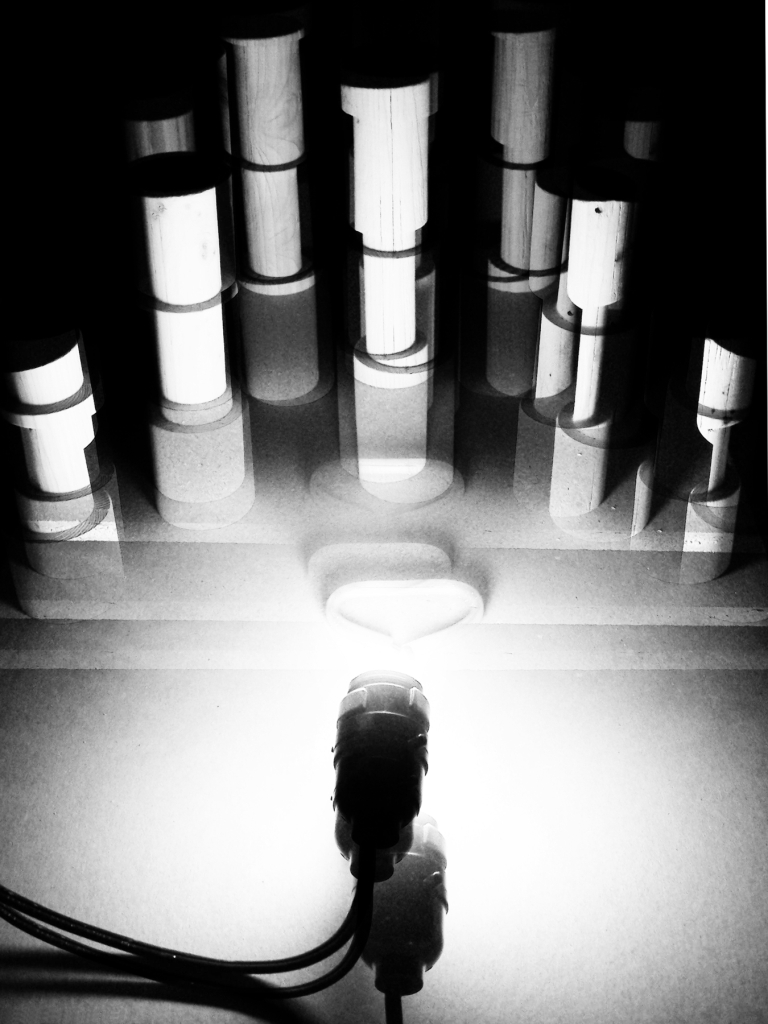
A mind-bending installation by John Fleischer at Air Sweet Air gallery
Lowertown’s Air Sweet Air gallery has a new exhibition up — it’s a show with satisfying intellectual heft and conceptual depth. And I have no idea what it all means. Called simply “Δ,” John Fleischer’s multimedia installation is distinguished by both its austerity and deliberateness. As you’d expect from the title, the show is pregnant with symbols and metaphysical allusions, but its overall meaning and message feels fluid, too, oblique and determinedly so — like a Zen koan or a Tibetan mandala. The work is open to interpretation, like a prompt for meditation.
The installation is a constellation of sculptural pieces, whose disparate configurations are offset by an extensive sequence of paintings projected high onto the gallery wall above them. As you enter the space, your eye is drawn to the tableaux at the center of the room, the axis mundi, if you like: three handmade cardboard box bottoms, aligned one atop the other in a vertical line; inside each is a collection of upright, sculpted wooden rods of varying heights, set in patterned arrangements, almost like chessmen. The boxes themselves are linked by loops of plastic-encased metal cable. Electrical cords wind around and among the boxes, powering a fluorescent light bulb affixed at alternating ends of each one; the light casts the spare assemblages in dramatic pools of intersecting light and shadow, especially when seen at night.
Adjacent to the boxes is a situation of organic fluids and vegetal matter, mason jars, denuded coffee and tomato paste cans, plastic basins and incandescent light bulbs. One of the tin cans is filled with what looks like tea left to sit and develop a thick scum. There’s a can of wax sitting on a hot plate, from the center of which springs a tall, slender wooden dowel. An upended, lonely incandescent bulb rests in an empty glass jar, which itself sits in an empty can. The composition is lit from above by another fluorescent bulb.
Similar, stripped down tin can/bulb/jar/light/effluvia arrangements are echoed in the corners of the gallery, like satellites to the main series of tableaux at the center.
A few feet away from the central elements of the piece, as if in conversation with and counterpoint to them, is a large protrusion of wood, a rough-hewn — no, hacked up — phallic lingam, beside which is a small iteration of the jar/bulb/light combination.
The projected paintings — 90 studies in all — offer variations on the patterning and arrangements of three-dimensional pieces. The paintings are notable for their crudely drawn, repeated patterns and grids, their looping cycles of peaks and valleys and thick sweeps of layered, translucent primary colors. The slides, viewed in quick succession, are entrancing — like obsessive visual articulations of ‘om.’
As you move through the installation, the activity of its creation — the maker’s hand and intention, his painstaking attention to detail — is inescapable, even if the particulars encoded therein are slippery. The installation feels like Fleischer’s meditation made manifest, filled with personal narratives and intellectual prompts, and unconcerned with, even resistant to conclusive definition from outside.
Indeed, even after repeated viewings, I can’t get any traction on a narrative analysis of Fleischer’s installation. Instead, I find my mind looping through interwoven snippets of associations and dualities — desire and detachment, light and shadow, creation and entropy, connection and dissolution, protrusions and vessels, intellect and carnality, stasis and flux.
Given the cerebro-spiritual nature of the installation, it’s fitting that the iconographic allusions I detect in the work are Asian in flavor: Mount Meru and the axis mundi, lingam and yoni, persistent mandala patterning, with a nod to both the ephemerality and emphasis on process you find in Tibetan sand paintings.
In his artist statement, Fleischer writes: “At its essence, the image [of the symbolic center, the axis mundi] describes a location organized around a point of transition. It is here where earth meets sky, where body and mind interact, where self encounters other … I am inspired by the regenerative opportunities [transformation narratives] offer when viewed as models for engaging the perpetual change of ordinary existence.”
It’s a thoughtful, even visionary work, but I defy you to neatly parse it.
“Δ,” an installation by John Fleischer, is on view through April 15; gallery hours by appointment at Air Sweet Air, 262 E. Fourth St., Ste. 203, St. Paul, Minn. For more information: http://airsweetair.org/home.html
Recent Content
-
Artsarticle ·
-
Artsarticle ·
-
Artsarticle ·


